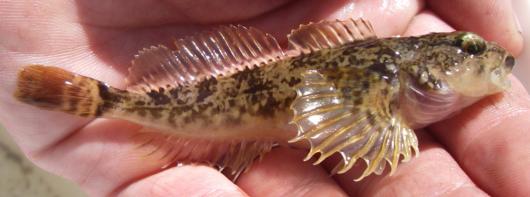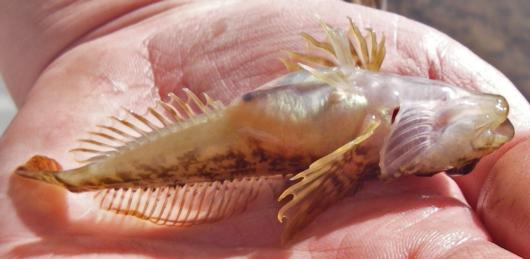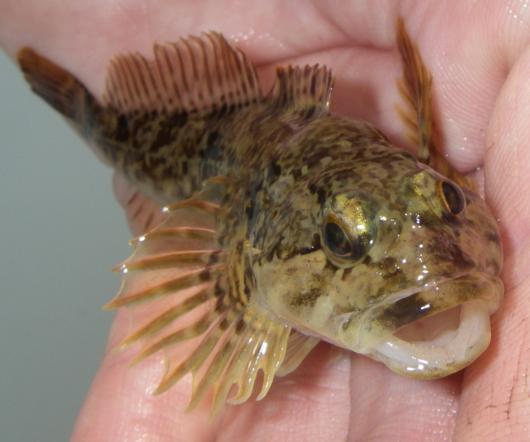Riffle Sculpin
-
Scientific NameCottus gulosus
-
NativeNative Species
-
Identification
 Riffle sculpin, side view. Location: South Fork American River. Date: 5 May 2010. Photo by Lisa C. Thompson.
Riffle sculpin, side view. Location: South Fork American River. Date: 5 May 2010. Photo by Lisa C. Thompson. Riffle sculpin, ventral view. Location: South Fork American River. Date: 5 May 2010. Photo by Lisa C. Thompson.
Riffle sculpin, ventral view. Location: South Fork American River. Date: 5 May 2010. Photo by Lisa C. Thompson. Riffle sculpin, frontal view. Location: South Fork American River. Date: 5 May 2010. Photo by Lisa C. Thompson.
Riffle sculpin, frontal view. Location: South Fork American River. Date: 5 May 2010. Photo by Lisa C. Thompson.- Adults up to 100 mm SL, larger sizes rare
- Large mouth, maxillary may reach rear margin of eye
- Prickles behind pectoral fins
- Pre-opercular spines: 2-3
- One median chin pore
- Joined dorsal fins (usually)
- Mottled coloration, black spot on rear side of 1st dorsal fin
- Spawning males dark, may have orange edge of 1st dorsal
- Fin spines/rays: pelvic 1 spine/3-4 rays, 1st dorsal 7-8 spines, 2nd dorsal 16-19 rays, pectoral 15-16 rays, anal 12-16 rays
- Pelvic fin "elements": 4 (1 spine, 3-4 rays, but the spine may be fused with the 1st ray)
- Lateral line: complete or incomplete, 22-36 pores
-
Life History
Riffle sculpins are found in headwater streams with cold water and rocky or gravelly substrate. They prefer permanent streams where the water does not exceed 25-26°C, and where ample flow keeps the dissolved oxygen level near saturation. Riffle sculpins may occupy riffles or pools, though they tend to favor areas that have adequate cover in the form of rocks, logs, or overhanging banks. These fish have similar habitat requirements similar to those of rainbow trout and are often found in association with them. Riffle sculpins are opportunistic feeders that may pursue prey by night or ambush during the day. The diet of a sculpin may include amphipods, benthic invertebrates, fish, and various stages of caddisflies and mayflies. Riffle sculpins reach sexual maturity in the end of their second year, with spawning taking place in late winter to early spring. Females lay 462-1,000 or more eggs under rocks within swiftwater reaches of a stream. The male takes the responsibility of guarding the nest which may contain the eggs of multiple females. Riffle sculpins rarely exceed 4 years of life.
-
Links to Other ResearchN / A
-
Watershed
-
Alisal-Elkhorn Sloughs Watershed
-
Bodega Bay Watershed
-
Coyote Watershed
-
East Branch North Fork Feather Watershed
-
Gualala-Salmon Watershed
-
Honcut Headwaters Watershed
-
Lower American Watershed
-
Lower Bear Watershed
-
Lower Butte
-
Lower Cache Watershed
-
Lower Cosumnes-Lower Mokelumne Watershed
-
Lower Cottonwood Watershed
-
Lower Feather Watershed
-
Lower Pit Watershed
-
Lower Sacramento Watershed
-
Lower Yuba Watershed
-
McCloud Watershed
-
Middle Fork Feather Watershed
-
Middle San Joaquin-Lower Chowchilla Watershed
-
Middle San Joaquin-Lower Merced-Lower Stanislaus Watershed
-
Mill Watershed
-
North Fork American Watershed
-
North Fork Feather Watershed
-
Pajaro Watershed
-
Russian Watershed
-
Sacramento Headwaters Watershed
-
Sacramento-Lower Cow-Lower Clear Watershed
-
Sacramento-Lower Thomes Watershed
-
Sacramento-Stone Corral Watershed
-
Sacramento-Upper Clear Watershed
-
Salinas Watershed
-
Salmon Watershed
-
San Francisco Bay Watershed
-
San Pablo Bay Watershed
-
South Fork American Watershed
-
Suisun Bay Watershed
-
Tomales-Drake Bays Watershed
-
Upper Bear Watershed
-
Upper Butte
-
Upper Cache Watershed
-
Upper Calaveras Watershed
-
Upper Coon-Upper Auburn Watershed
-
Upper Cosumnes Watershed
-
Upper Cow-Battle Watershed
-
Upper Kaweah Watershed
-
Upper King Watershed
-
Upper Merced Watershed
-
Upper Mokelumne Watershed
-
Upper Putah Watershed
-
Upper San Joaquin Watershed
-
Upper Stanislaus Watershed
-
Upper Tuolumne Watershed
-
Upper Yuba Watershed
-
Please note, watersheds are at the USGS 8-digit Hydrologic Unit Code (HUC) scale, so they often include a lot of sub-watersheds. If a species occurs in any sub-watershed within the HUC, the species appears within the HUC. Link to an EPA page that shows HUCs.


